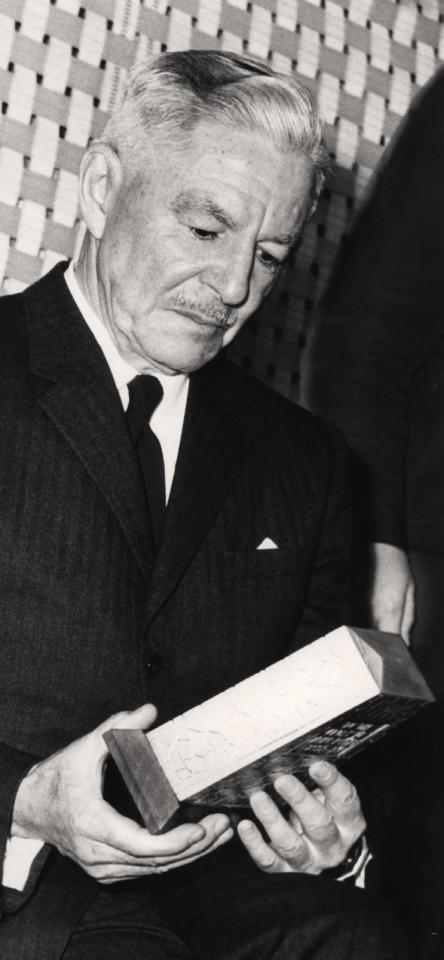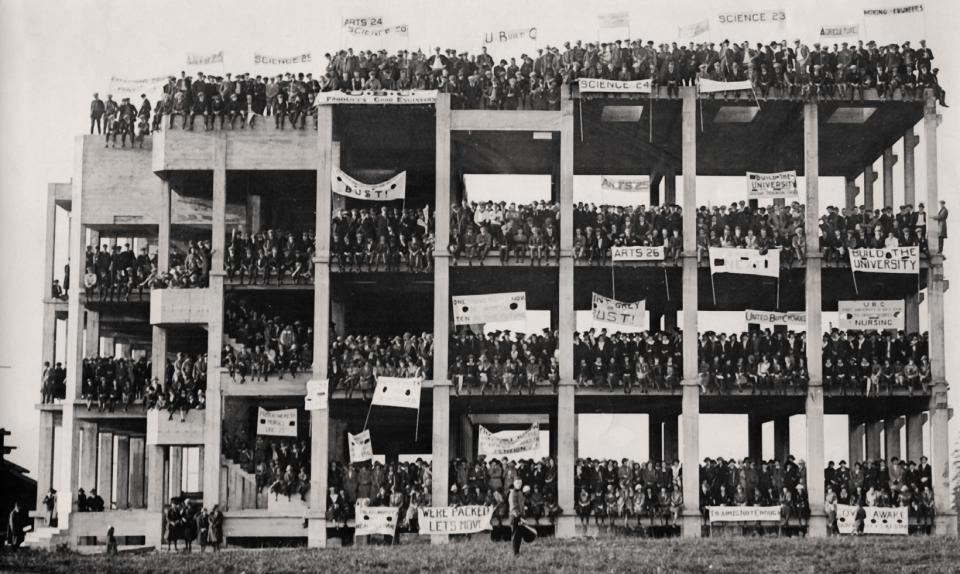The Great Trek
On September 22, 1925, the university held its first classes at the new Point Grey campus. The move from the site of what is now the Vancouver General Hospital to Point Grey was an important part of UBC’s history, but that was not in and of itself the story. The real story was the massive student‑conceived and executed publicity campaign that convinced the government to provide funds to build the university and move it from its overcrowded facilities at the Fairview site. The campaign culminated in the Pilgrimage, or what we now call the Great Trek.
The Legislature had approved funds to clear the 175‑acre site at Point Grey in 1913, and work began on the Science Building the following summer. However, the First World War began soon after the concrete and steel framework began to take shape, and with the diversion of resources to the war effort, the government stopped construction. The bare girders of the Science Building would serve as a monument to the unrealized vision of the Point Grey campus for almost a decade.
Everyone viewed the use of the shacks at Fairview as an exigency measure and hoped that work would soon resume at Point Grey. But with a depleted treasury, the provincial government did not consider the university a high priority. UBC spent its first decade at Fairview. Unfortunately, President Wesbrook died shortly before the armistice in 1918. He was replaced by Dean of Agriculture Leonard Klinck.
The inadequacy of the Fairview facilities became increasingly apparent with each passing year. Between 1916 and 1922 UBC enrolment expanded by 211 per cent (from 378 to 1,178), while the capacity of the buildings grew by only 25 per cent. The wards of a small three‑floor former hospital building made reasonably good classrooms, while the rest of the facilities, including the Auditorium, offices and lecture rooms, were housed in old army shacks. Additional space had to be found as the number of students grew. Professors held agriculture classes in a private residence, French classes in the basement of a church unused by its congregation during the week, and chemistry classes in the famous chemistry tent erected on the site. Professors often had to repeat their lectures several times because not enough adequate classroom space existed and neither students nor faculty members had proper laboratory facilities. The Auditorium, used for general assemblies, held only 650 people. But the close quarters and relatively small student numbers produced a cohesive and united student body, and a strong sense of community between students and faculty. This spirit set the stage for the events of 1922.
Professors held agriculture classes in a private residence, French classes in the basement of a church unused by its congregation during the week, and chemistry classes in the famous chemistry tent erected on the site. Professors often had to repeat their lectures several times because not enough adequate classroom space existed.
By the spring of 1922, students began organizing a campaign to generate support for the resumption of construction at Point Grey. Returned war veteran and AMS president‑elect Albert “Ab” Richards (Class of ‘23) became leader of the “Build the University” campaign. As a first step in what would become a massive and well‑organized undertaking, students were asked to take petitions back to their hometowns in the summer and collect at least 25 signatures. The petition read, in part: “... we the undersigned humbly petition the Government of the Province of British Columbia to institute a definite and progressive policy toward the University of British Columbia, and to take immediate action toward the erection of permanent buildings on the chosen University site at Point Grey.” While students collected signatures at home, the Publicity Campaign Committee consisting of Richards, Marjorie Agnew, Percy Barr, J.V. Clyne, Allan H. Finlay, Jack Grant, and Aubrey Roberts co‑ordinated activities in Vancouver and organized meetings with service clubs and business leaders to promote their cause.
Students returned in the fall with 17,000 signatures on their petitions. Leaders felt that the numbers, though impressive, were not enough to convince the government to take action. As part of Varsity Week (October 22‑28), the students conducted a door‑to‑door canvas in Vancouver to increase the number of signatures. They divided the city with each class responsible for canvassing in specific sections. Just prior to the Vancouver canvas, a special edition of the Ubyssey provided students with facts and figures they could use in promoting the cause. The instructions also made clear that the success of this exercise depended on every student doing his or her part, and reminded them that as representatives of the university their behaviour would have an effect on public opinion. At the end of the organized petition blitz, students had collected 56,000 signatures. Students also solicited support from service agencies and other organizations. During Varsity Week, many store windows included displays and posters supporting the campaign. Newspapers, too, carried stories about the campaign as the students established their own news service to send regular campaign updates throughout the province. President Klinck observed:
No effort on the part of the authorities has ever attracted the attention of the public as has the campaign now being carried on by the students for removal of the University to Point Grey. Their enthusiasm is contagious. Everywhere one goes questions are asked as to the progress of the campaign and the best wishes are expressed for the success of the movement. The initiative, resource and energy with which the canvas is being prosecuted has caught and fired the imagination of men and women in all parts of the province.” (The Ubyssey, 17 October 1922)
At Granville and Davie the students boarded trolley buses provided by BC Electric Railway and rode to the end of the line at 10th Avenue and Sasamat. They continued on foot along what was little more than a wagon trail to the Point Grey campus.
As the student campaign neared its end, only one critical event remained. The Pilgrimage (the term Great Trek would be coined some 25 years later) was set to end Varsity Week on Saturday, October 28. Nearly 1,200 students showed up, along with banners and placards, floats and a marching band. The procession began at the east end of the Georgia viaduct and made its way through downtown Vancouver along Main, Hastings and Granville. At Granville and Davie, the students boarded trolley buses provided by BC Electric Railway and rode to the end of the line at 10th Avenue and Sasamat. They continued on foot along what was little more than a wagon trail to the Point Grey campus. Along the way students continued to sing and chant. Lyrics for one of the official marching songs composed for the event conveyed their sentiments.
We’re through with tents and hovels,
We’re done with shingle stain,
That’s why we want you to join us
And carry our Campaign.
The Government can’t refuse us
No matter what they say,
For we’ll get the people voting
For our new home at Point Grey.
The students gathered on the west side of the skeleton of the Science Building and then climbed the concrete stairs to take their place. That symbolic occupation and the familiar formation of the letters “UBC” with student bodies were staged so they could be recorded for posterity by newsreel cameramen conveniently attending the event.
The Pilgrimage ended with the dedication of the cairn that still stands on Main Mall in front of the Chemistry Building. Students threw stones in the hollow centre of the structure that had been designed by the university architects and built from rocks gathered on the campus site. It was fitting that the students completed the first structure at Point Grey. Richards expressed the hope that “very soon around our Cairn of rock buildings will rise and a university will be established which will bring honour and glory to our Alma Mater and renown to our Province and Dominion.”
In the week following the Pilgrimage, a student delegation of Richards, Grant, Clyne and Barr packed the 56,000‑name petition in seven suitcases and on November 1 met with the cabinet and the Legislature in Victoria. Captain Ian Mackenzie, a Vancouver MLA and an active supporter of the campaign introduced the delegation, and six page‑boys hauled the petition roles into the House. Then Richards addressed the Legislature. This persuasive presentation and obvious public support helped convince the provincial government to resume work on the Point Grey campus and within a week the premier announced that the government would secure a $1.5 million loan to proceed. These funds completed the Science Building and built the Library and powerhouse according to the original plans. Completed in 1923 and 1925 respectively, the Science Building and Library stood as impressive but isolated structures on the stark campus. In the spring of 1924, work began on six new frame and stucco “semi‑permanent” buildings to house Agriculture, Applied Science, Arts, the Auditorium, and the administration.
On September 22, 1925, 1,400 students crowded into the Auditorium and stood for the university’s first inaugural general assembly. The campus to which the students travelled on that day was significantly less grandiose than that envisaged in the original 1914 plans. Only a few modest buildings dotted the landscape, there were no trees or grass, and roads and sidewalks were still under construction. Students had no playing fields or gymnasium, piles of construction debris littered the campus and mud and dust were everywhere. Despite these shortcomings, this was the university campus that the students had, with single‑minded determination, worked so hard to achieve.
Student involvement in the Great Trek and the entire publicity campaign represents a remarkable, but not isolated, chapter in UBC’s history. The events of 1922 should be viewed as the beginning of a trend. Subsequent student initiatives led to the construction of several campus buildings including the Gymnasium (1929), Brock Hall (1940), Armoury (1941), War Memorial Gymnasium (1951) and the Student Union Building (1968). Although perhaps not on the scale of the Great Trek, these initiatives too, helped define the university.
A version of this article was published in the inaugural issue of Trek magazine in 2001.





































